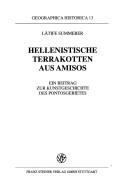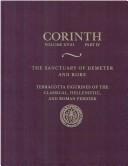| Listing 1 - 10 of 17 | << page >> |
Sort by
|
Book
ISBN: 9781108488143 9781108769020 9781108738460 Year: 2020 Publisher: Cambridge : Cambridge University Press,
Abstract | Keywords | Export | Availability | Bookmark
 Loading...
Loading...Choose an application
- Reference Manager
- EndNote
- RefWorks (Direct export to RefWorks)
"This book is a material culture study, with strong roots in both anthropology (particularly theories of miniaturization and human engagement, as well as the reconstruction of embodied subjectivities) and art history (with focus on iconography, formal properties, and visual engagement). Evidence of archaeological context, beyond the broad contextual information of city/site of discovery, is not taken heavily into account. The reason for this is, simply, that contextual information for these figurines is often problematic. Many were unearthed in the early twentieth century, when archaeological context was not well documented. Small finds from the late periods of Mesopotamian history, a category that includes Hellenistic-era figurines, were not particularly valued or well recorded. Due to their presence in some of the last levels of occupation prior to site abandonment, many were surface finds. Even when meticulous archaeological investigation took place, as in the recent Italian excavations at Seleucia-on-the-Tigris, difficulties with determining context or precise chronology were still common. Primary among those difficulties is that most figurines seem not to have been considered particularly valuable or sacred by their ancient users, and so could be disposed of in domestic refuse or reused - thus the final deposition context of a figurine is often not where it was originally used as a figural object. Other scholars have made valiant attempts to grapple with these archaeological issues; for instance, Roberta Menegazzi's 2014 catalogue of the Seleucia-on-the-Tigris figurines deftly explores these complexities and offers many valuable interpretations"--
Terra-cotta figurines, Hellenistic --- Art and society --- History --- Iraq --- Civilization
Book

ISBN: 0892414952 0892414960 Year: 1990 Publisher: New York Caratzas
Abstract | Keywords | Export | Availability | Bookmark
 Loading...
Loading...Choose an application
- Reference Manager
- EndNote
- RefWorks (Direct export to RefWorks)
Book
ISBN: 9654065568 Year: 2003 Publisher: Jerusalem : Israel Antiquities Authority,
Abstract | Keywords | Export | Availability | Bookmark
 Loading...
Loading...Choose an application
- Reference Manager
- EndNote
- RefWorks (Direct export to RefWorks)
Civilization, Subterranean. --- Terra-cotta figurines, Hellenistic. --- Excavations (Archaeology) --- Caves.
Book
ISBN: 8871662202 Year: 1995 Publisher: Firenze : Casa editrice le lettere,
Abstract | Keywords | Export | Availability | Bookmark
 Loading...
Loading...Choose an application
- Reference Manager
- EndNote
- RefWorks (Direct export to RefWorks)
Terra-cotta figurines, Hellenistic --- Terra-cotta figurines, Hellenistic --- Catalogs. --- Foreign influences. --- Matḥaf al-ʻIrāqī. --- British Museum. --- Musée du Louvre.
Book
ISBN: 9783110598131 3110598132 Year: 2018 Publisher: Berlin De Gruyter
Abstract | Keywords | Export | Availability | Bookmark
 Loading...
Loading...Choose an application
- Reference Manager
- EndNote
- RefWorks (Direct export to RefWorks)
In den Jahren 1973–1993 wurden im Rahmen der Stadtgrabung in der Wohnstadt Pergamons auch rund 5.400 Terrakottafragmente ausgegraben, die in der Mehrzahl vermutlich als Hausinventar gedient haben und überwiegend aus der hellenistischen Epoche und der römischen Kaiserzeit stammen. 1030 thematisch äußerst vielfältige Stücke wurden für den Katalog dieser Arbeit ausgewählt. Für die Einordnung der nun komplett und ausführlich vorgelegten Stadtgrabungsterrakotten wurden viele ältere und neuere Terrakotten aus anderen Grabungen in Pergamon in die Betrachtungen einbezogen. So enthält der Band eine Übersicht über die Themen und Kontexte der bekannten pergamenischen Terrakotten. Um auf Vergleichen basierende Datierungs-vorschläge nachvollziehbar zu machen, wurde ein chronologischer Apparat erstellt. Die in der Stadtgrabung gefundenen Terrakotten sind Ausdruck einer regen städti-schen Produktion und Nachfrage. Die Göttermutter (Kybele) ist die am häufigsten abgebildete Gottheit, gefolgt von Aphrodite- und Erosdarstellungen und Bildern des dionysischen Themenkreises (Dionysos & Thiasos, Schauspieler, Theatermasken). Wichtige Gottheiten wie Asklepios und Athena, denen die größten und bedeutends-ten Heiligtümer in der Stadt geweiht waren, waren in der wohnstädtischen Koroplas-tik (und darüber hinaus) ein auffällig nachrangiges Thema. Insgesamt überwiegen die Darstellungen von Frauen, Männerfiguren waren viel seltener. Unter den Tonobjekten bilden die Protomai verschleierter Frauen und größere und kleinere dionysische Mas-kenobjekte markante Gruppen. Für die Terrakotten der Stadtgrabung konnte eine Reihe von Vergleichsstücken aus anderen Regionen ermittelt werden, von Myrina über Athen bis Unteritalien. Besonderes Augenmerk liegt in diesem Buch auf den überaus engen Verbindungen zur Sepulkralkoroplastik Myrinas.
Excavations (Archaeology) --- Terra-cotta sculpture, Hellenistic --- Terra-cotta figurines, Hellenistic --- Bergama (Turkey) --- Antiquities. --- E-books
Book
ISBN: 1283283980 9786613283986 9004222669 9789004222663 9789004207974 900420797X Year: 2011 Publisher: Leiden BRILL
Abstract | Keywords | Export | Availability | Bookmark
 Loading...
Loading...Choose an application
- Reference Manager
- EndNote
- RefWorks (Direct export to RefWorks)
This book investigates Hellenistic popular religion through an interdisciplinary study of terracotta figurines of Egyptian deities, mostly from domestic contexts, from the trading port of Delos. A comparison of the figurines’ iconography to parallels in Egyptian religious texts, temple reliefs, and ritual objects suggests that many figurines depict deities or rituals associated with Egyptian festivals. An analysis of the objects’ clay fabrics and manufacturing techniques indicates that most were made on Delos. Additionally, archival research on unpublished notes from early excavations reveals new data on many figurines’ archaeological contexts, illuminating their roles in both domestic and temple cults. The results offer a new perspective on Hellenistic reinterpretations of Egyptian religion, as well as the relationship between “popular” and “official” cults.
Terra-cotta figurines, Hellenistic --- Cults --- Delos Island (Greece) --- Egypt --- Religion. --- Religion --- Influence.

ISBN: 3515074090 Year: 1999 Publisher: Stuttgart Steiner
Abstract | Keywords | Export | Availability | Bookmark
 Loading...
Loading...Choose an application
- Reference Manager
- EndNote
- RefWorks (Direct export to RefWorks)
Terra-cotta figurines, Hellenistic --- Samsun (Samsun İli, Turkey) --- Turkey --- Antiquities. --- Antiquities.
Book
ISBN: 3895002259 Year: 2001 Volume: Heft 1. Publisher: Wiesbaden Reichert
Abstract | Keywords | Export | Availability | Bookmark
 Loading...
Loading...Choose an application
- Reference Manager
- EndNote
- RefWorks (Direct export to RefWorks)
Book
ISBN: 1108854486 1108769020 1108488145 1108848303 Year: 2020 Publisher: Cambridge : Cambridge University Press,
Abstract | Keywords | Export | Availability | Bookmark
 Loading...
Loading...Choose an application
- Reference Manager
- EndNote
- RefWorks (Direct export to RefWorks)
In this volume, Stephanie M. Langin-Hooper investigates the impact of Greek art on the miniature figure sculptures produced in Babylonia after the conquests of Alexander the Great. Figurines in Hellenistic Babylonia were used as agents of social change, by visually expressing and negotiating cultural differences. The scaled-down quality of figurines encouraged both visual and tactile engagement, enabling them to effectively work as non-threatening instruments of cultural blending. Reconstructing the embodied experience of miniaturization in detailed case studies, Langin-Hooper illuminates the dynamic process of combining Greek and Babylonian sculpture forms, social customs, and viewing habits into new, hybrid works of art. Her innovative focus on figurines as instruments of both personal encounter and global cultural shifts has important implications for the study of tiny objects in art history, anthropology, classics, and other disciplines.
Terra-cotta figurines, Hellenistic --- Hellenistic terra-cotta figurines --- Art and society --- History --- Iraq --- Civilization --- Art --- Art and sociology --- Society and art --- Sociology and art --- Social aspects

ISBN: 0876611846 Year: 2000 Publisher: Princeton (N.J.) American school of classical studies at Athens
Abstract | Keywords | Export | Availability | Bookmark
 Loading...
Loading...Choose an application
- Reference Manager
- EndNote
- RefWorks (Direct export to RefWorks)
Terra-cotta figurines --- Terra-cotta figurines, Classical --- Terra-cotta figurines, Greek --- Terra-cotta figurines, Hellenistic --- Sanctuary of Demeter and Persephone (Corinth, Greece) --- Hellenistic terra-cotta figurines --- Greek terra-cotta figurines --- Classical terra-cotta figurines --- Figurines --- Terra-cotta sculpture
| Listing 1 - 10 of 17 | << page >> |
Sort by
|

 Search
Search Feedback
Feedback About UniCat
About UniCat  Help
Help News
News